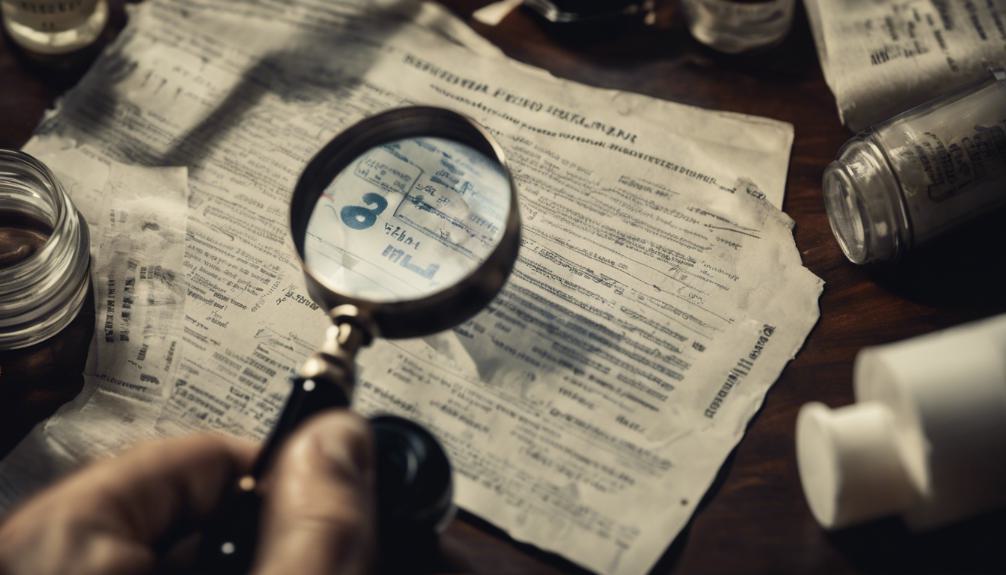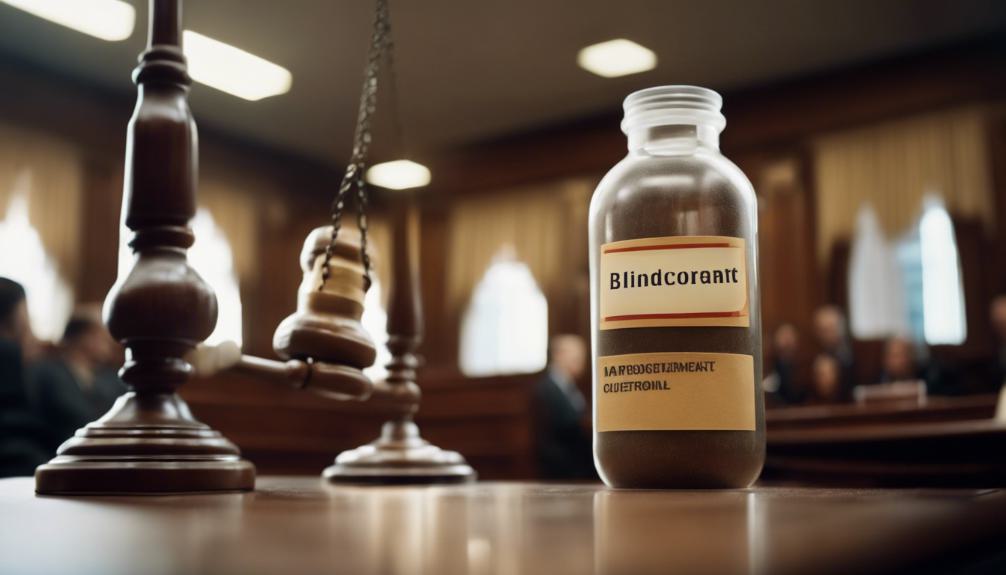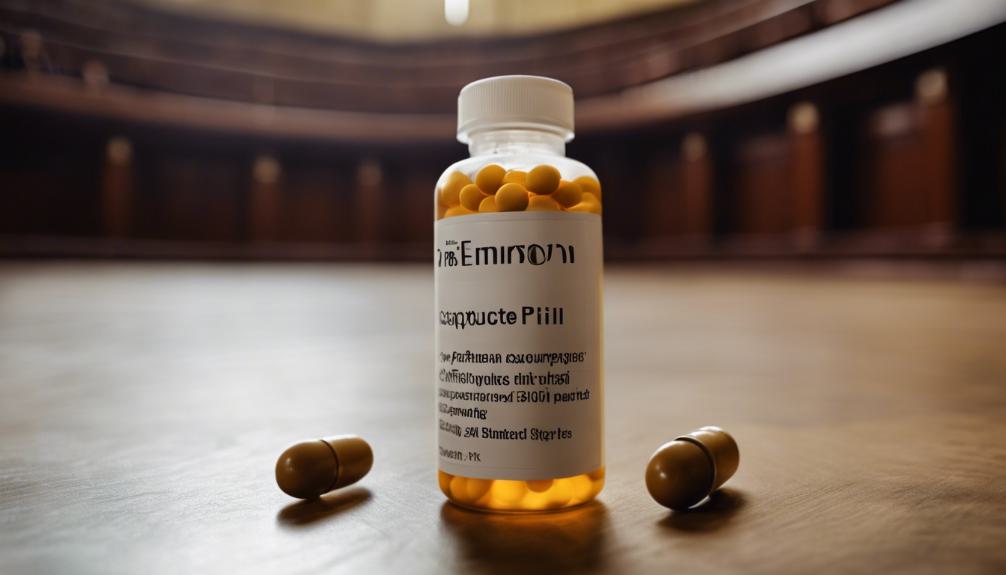Elmiron Scandal: Blind Risk Lawsuit Ignites Fury
The Elmiron scandal has surfaced significant ethical and legal concerns within the pharmaceutical industry, highlighting a profound dilemma between patient safety and pharmaceutical efficacy. As lawsuits against Janssen Pharmaceuticals and its affiliates accumulate, alleging failure to warn about the severe risk of permanent vision damage, the discourse around corporate responsibility and consumer protection intensifies. This controversy not only sheds light on the potential oversight in drug safety evaluations but also raises critical questions about the transparency and accountability of drug manufacturers. Engaging in this discussion offers an opportunity to explore the intricate balance between innovation and the imperative to safeguard public health.
Key Takeaways
- Elmiron is linked to a unique eye condition, PPS maculopathy, leading to lawsuits against its manufacturers.
- Patients were not warned about the potential for vision impairment from Elmiron use.
- The drug was released with insufficient testing, raising concerns about its effectiveness and safety.
- Centralization of lawsuits in New Jersey underscores the widespread impact of Elmiron-related eye injuries.
Elmiron Lawsuit Overview

The Elmiron lawsuit encapsulates a significant legal battle, alleging that the drug's manufacturers failed to adequately warn users about the risk of a unique eye injury known as PPS maculopathy. This case underscores a profound duty of care that pharmaceutical companies must uphold to protect consumers from harm. By failing to provide sufficient warnings about potential vision impairment risks, the defendants, including Janssen, Ortho-McNeil, Alza, and Johnson & Johnson, neglected their responsibility to inform users, prescribers, and regulators about the dangers associated with prolonged Elmiron usage. This oversight has led to users continuing their medication, unaware of the accumulating risk to their eyesight, thereby emphasizing the necessity for stringent safety protocols and transparent communication within the healthcare industry to safeguard public health.
Eye Injury Allegations

Building on the overview of the Elmiron lawsuit, allegations of eye injury center on the reported link between the drug and a unique form of maculopathy, raising serious concerns about patient safety. This rare yet severe eye condition, known as PPS maculopathy, has been directly associated with the prolonged use of Elmiron. Affected individuals have reported a range of symptoms, from blurred and cloudy vision to significant vision loss, sparking a wave of legal actions. The core of these allegations lies in the assertion that patients were not adequately warned about the potential risks of eye damage, leading many to continue the medication without knowledge of the harm it could cause. This negligence has fueled a demand for accountability and a reevaluation of the drug's safety profile.
Defendants and Accusations

Several pharmaceutical companies, including Janssen, Ortho-McNeil, Alza, and Johnson & Johnson, face allegations for failing to warn users about the vision impairment risks associated with Elmiron. These companies are accused of neglecting their duty to inform not only the users but also prescribers and regulators about the potential for eye injury risks from the prolonged use of Elmiron. The heart of these accusations lies in the alleged disregard for the well-being of patients, prioritizing profits over the health and safety of individuals relying on their products for medical relief. The legal actions taken aim to hold these entities accountable, seeking justice for those adversely affected and ensuring such oversight does not recur, reflecting a commitment to safeguarding public health and upholding ethical standards in pharmaceutical practices.
Warning Sign Deficiencies

In addressing the deficiencies in warning signs, it becomes apparent that pharmaceutical companies allegedly neglected to provide adequate information regarding the vision impairment risks associated with Elmiron. This oversight has profound implications for patient safety and trust in healthcare. Individuals who seek to aid and serve others in the medical and legal fields are now faced with the challenge of mitigating the harm caused by this information gap. The absence of clear warnings has not only compromised patients' ability to make informed decisions about their health care but also hindered medical professionals' capacity to prevent and address potential adverse effects effectively. This situation underscores the critical need for transparency and diligence in communicating drug-related risks, ensuring that patient welfare remains at the forefront of pharmaceutical practices.
The Risk of PPS Maculopathy

Understanding the relationship between Elmiron and the development of PPS maculopathy has become a critical concern for both patients and healthcare professionals. Elmiron, a drug intended for bladder pain relief, has been linked to a unique and severe eye condition known as PPS maculopathy. This condition can lead to significant vision impairment, including difficulties with reading, adapting to dim lighting, and recognizing faces. The allegations against Janssen Pharmaceuticals and related companies focus on their failure to warn users and healthcare providers about the potential risks of eye damage. As a result, many individuals continued their medication regimen unaware of the potential harm, leading to irreversible vision loss for some. This situation underscores the importance of vigilant monitoring and transparent communication regarding medication side effects to protect patient health.
Testing and Efficacy Issues

Despite its widespread use, Elmiron underwent insufficient testing to fully understand its effectiveness and potential side effects. This lack of thorough evaluation has raised significant concerns among healthcare professionals and patients alike. Elmiron, prescribed for interstitial cystitis, a chronic condition causing bladder pain and pressure, was introduced without a clear understanding of its pharmacodynamics or pharmacokinetics. Consequently, its mechanism of action remains poorly understood, and the drug requires relatively high doses to achieve minimal therapeutic effects. Additionally, the absence of reliable markers to predict adverse reactions further complicates its safe administration. This oversight in the drug's testing and efficacy assessment not only undermines the trust in pharmaceutical oversight but also jeopardizes patient safety, leaving many to grapple with unforeseen health complications.
Multidistrict Litigation Unfolds

Amid concerns regarding Elmiron's testing and efficacy, the legal focus has shifted towards the consolidation of numerous lawsuits into a multidistrict litigation in the District of New Jersey. This strategic legal maneuver aims to streamline proceedings, allowing for a more efficient handling of cases that share common allegations against the manufacturers of Elmiron. By centralizing these lawsuits, plaintiffs hope to strengthen their collective bargaining position and expedite the process of seeking justice for those who have suffered due to inadequate drug testing and transparency. This multidistrict litigation underscores the commitment of legal professionals to assist individuals in holding large pharmaceutical companies accountable, reflecting a broader dedication to public health and safety.
Elmiron and Vision Loss

Elmiron, a prescription medication widely used for bladder pain, has been increasingly linked to a serious form of vision loss known as PPS maculopathy. This condition, which can severely impair vision, has raised significant concerns among patients and healthcare providers alike. As individuals dedicated to aiding others, it is important to understand the gravity of this issue. PPS maculopathy is characterized by changes in the macula, the part of the eye responsible for sharp, central vision. The growing body of evidence suggesting a link between Elmiron and this debilitating eye condition underscores the importance of vigilance and informed decision-making in healthcare. For those affected, early detection and intervention are key to preventing further vision loss, highlighting the need for thorough patient education and support.
Study Confirms Retinal Damage

Building on the concerns surrounding Elmiron's link to vision loss, a recent study has unequivocally confirmed the medication's association with retinal maculopathy. The findings present a significant alarm for health professionals and patients alike, underscoring the need for immediate reassessment of the drug's safety profile. This development is particularly concerning for individuals who have been using Elmiron for prolonged periods, as they may be at heightened risk of enduring irreversible vision impairment. The study's conclusions serve as a critical call to action, advocating for increased vigilance and a reevaluation of prescribing practices. It emphasizes the importance of patient education on potential risks, ensuring that those who seek to alleviate their suffering are not inadvertently exposed to harm.
Legal Proceedings Update

Recent developments in the Elmiron litigation have seen hundreds of lawsuits centralized in the District of New Jersey, marking a significant phase in the ongoing legal battle over the drug's alleged vision-damaging side effects. This centralization is a critical step towards ensuring that those affected by Elmiron's potential harms have a unified platform to seek justice and compensation. It underscores the legal system's responsiveness to claims that merit serious attention, aiming to address the grievances of individuals who trusted in the safety of their medications. This phase of the litigation process not only highlights the importance of vigilance in pharmaceutical safety but also reinforces the commitment to upholding the rights and well-being of patients. The progression of these proceedings is closely watched by many, symbolizing a quest for accountability and transparency in the pharmaceutical industry.
Elmiron's Controversial Impact

The controversy surrounding Elmiron has escalated as mounting evidence implicates the drug in severe vision-related side effects, leading to widespread legal and medical scrutiny. Initially hailed for its potential benefits in treating interstitial cystitis, a closer examination reveals a troubling lack of thorough testing and understanding of the drug's mechanism of action. This oversight has resulted in patients enduring irreversible harm, unaware of the risks associated with prolonged use. The medical community is now faced with the challenge of addressing these severe outcomes, emphasizing the need for rigorous drug evaluation processes. As healthcare professionals, our priority is to safeguard the well-being of those we serve, necessitating a reevaluation of how drugs are tested and approved, ensuring transparency and accountability in pharmaceutical practices.
Seeking Justice and Awareness

Amidst growing concerns over Elmiron's adverse effects, efforts to seek justice and raise awareness about the drug's potential risks have intensified. Advocates and victims alike are rallying to illuminate the dark corners of pharmaceutical negligence, emphasizing the critical need for transparent communication and stringent testing protocols. The lawsuits against Janssen Pharmaceuticals and its affiliates not only seek reparation for those harmed but also aim to mandate a higher standard of accountability within the industry. By centralizing cases in multidistrict litigation, the legal strategy underscores the widespread nature of the grievance while facilitating a unified front against the disregard for patient safety. This concerted push for justice and heightened awareness serves as a beacon for future pharmaceutical vigilance, ensuring that the well-being of patients remains at the forefront of drug development and distribution.
Frequently Asked Questions
How Do Patients Currently Taking Elmiron Protect Their Vision While Awaiting Further Legal or Medical Guidance?
Patients currently taking Elmiron and concerned about protecting their vision should consult their healthcare provider for personalized advice. It's prudent to discuss the risks and benefits of continuing Elmiron treatment, considering the recent findings. Regular eye examinations may be recommended to monitor for any changes in vision. Additionally, exploring alternative therapies with a healthcare professional can be a viable option, ensuring that treatment decisions are informed and tailored to individual health needs.
Are There Alternative Treatments for Interstitial Cystitis That Do Not Carry the Same Risks of Vision Impairment?
Exploring alternatives for Elmiron for interstitial cystitis involves juxtaposing the benefits of traditional treatment against the necessity of safeguarding vision. For those committed to serving others by providing compassionate healthcare, it is crucial to contemplate treatments such as physical therapy, diet modifications, pain management, and other oral medications that lack Elmiron's associated risk of vision impairment. These alternatives offer a holistic approach to managing symptoms while prioritizing patient safety and well-being.
What Steps Should Someone Take if They Suspect They Might Be Experiencing Vision-Related Side Effects From Elmiron?
If someone suspects they are experiencing vision-related side effects from Elmiron, they should immediately consult with a healthcare provider, preferably an ophthalmologist, for a thorough eye examination. It is essential to discuss the history of Elmiron use with the healthcare professional to assess the potential link to the eye condition. Additionally, considering legal consultation to understand rights and potential actions regarding the situation is advisable, as there are ongoing litigations related to these concerns.
How Can Affected Elmiron Users Participate in the Ongoing Litigation if They Believe They Have Suffered Vision Loss as a Result of the Drug?
Individuals who suspect they have experienced vision loss due to Elmiron use may consider joining the ongoing litigation by first consulting with a legal professional experienced in pharmaceutical litigation. It's imperative to gather and document all medical records related to their condition, as these will be critical for substantiating claims. Additionally, potential claimants should act swiftly due to statutes of limitations, which vary by jurisdiction, to guarantee their eligibility to participate in the lawsuit.
What Are the Long-Term Prognosis and Potential Treatments for Individuals Diagnosed With PPS Maculopathy as a Result of Elmiron Usage?
While some may question the relevance of discussing specific treatments in the broader context of pharmaceutical litigation, it is imperative to focus on the well-being of those affected. For individuals diagnosed with PPS maculopathy due to Elmiron usage, the long-term prognosis varies. Treatment options are currently limited and primarily aim to stabilize vision and prevent further deterioration. Regular monitoring by a healthcare professional specializing in retinal diseases is recommended to manage the condition effectively.
Conclusion
To summarize, the Elmiron litigation underscores the critical need for rigorous drug testing, transparent communication of potential risks, and accountability from pharmaceutical companies. It highlights the importance of safeguarding patient health, ensuring informed consent, and fostering trust between healthcare providers and those they serve. As legal proceedings progress, the pursuit of justice for affected individuals and heightened awareness of PPS maculopathy's risks stand as paramount. This case epitomizes the intersection of medical ethics, legal responsibility, and patient advocacy in the contemporary healthcare landscape.

This post has been generated by AI and was not reviewed by editors. This is Not legal advice. Please consult with an attorney.